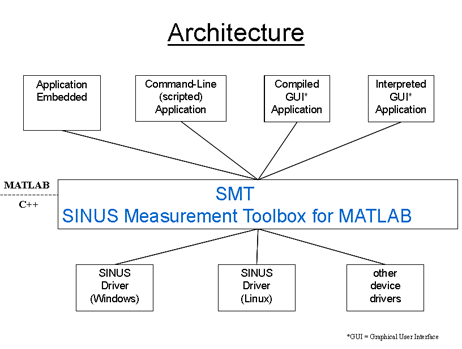SMT
SINUS Measurement Toolbox for MATLAB®
Overview
With the SINUS Measurement Toolbox for MATLAB® (SMT) , scientists and engineers using Soundbook™, Apollo™, Tornado™ und Typhoon™ can harness the full power, flexibility and high performance of the most important software tool in the field of technical computing: MATLAB®.
The SMT is not just a file export interface delivering data in a MATLAB-readable format: it provides MATLAB programmers with an easy-to-use control interface which also allows data to be accessed both during and after the data acquisition. The SMT implements a consistent interface between MATLAB and the various families of SINUS instruments.
Various types of applications are possible. Using the SMT, the SINUS hardware can be directly controlled from the MATLAB command line or from user-written functions. In addition to running programs in the interpreter mode, as is possible for every user having a MATLAB license, the MATLAB programs can also be compiled. The license-freedom of such programs is of considerable economic importance for the end-user. As a Connections Program Partner of the MathWorks Inc., SINUS Messtechnik GmbH can also support you in the development of your own MATLAB applications.
The application developer is provided with a clear and consistent conceptual model, and does not have to spend an inordinate amount of time learning device-specific interface procedures and data structures. This technology enables the user to easily exploit our devices with a minimum of programming.
Three concepts are fundamental to the SMT:
Devices physical or virtual (file) devices
Channels logical data streams from or to the device
Properties defined attributes of devices and channels which can be read and (where appropriate) set
The key characteristics of the SMT are:
- Reliable and stable foundation for application programming
- Independence from operating system and drivers
- Large degree of software reusability and accelerated development
- Simplified data acquisition with scalable number of physical/logical channels
Current applications include:
- Development of algorithms and applications for sound and vibration measurement technology
- Environmental and meteorological research (acoustic tomography, rain radar)
- Analysis methods for vehicle acoustics
- Teaching of acoustics
- Vibration diagnosis for machine maintenance purposes
- AcoustiCam™ software package for sound-field holography.
The SMT contains as standard several example applications such as a configurator, an oscilloscope, a recorder and a data converter as fully commented source code (M-files). These examples serve as templates for application programmers and can already be used for simple measurements. They may be modified and/or included in your own applications without any restrictions.
Requirements
- At least Intel® Pentium® Prozessor or AMD Athlon™ XP Prozessor (Intel® Core™2 Duo Prozessor recommended)
- 1 GB RAM
- Windows® XP, Vista, 7
- Measurement hardware: HARMONIE™, Apollo™, Soundbook™, SWING™, Hurricane™, Tornado, Typhoon


